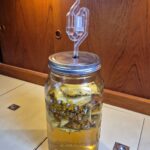Tepache
Fermented pineapple drink
Equipment
- 1 fermentation vessel we use a large glass jar with an airlock so the contents do not spill on the boat, though you can use a large plastic bowl, pitcher, or even a large pot.
- 2-4 soda bottles can be glass or plastic and must be capable of holding the pressure of carbonation
- 1 fine mesh strainer
- 1 funnel
Ingredients
- 1 ripe pineapple only the skin and rind are needed – use the flesh of the pineapple as you normally would
- 1 cinnamon stick optional
- 1 cup brown sugar or 1 large cone of piloncillo if available
- 2-3 liters water
Instructions
- The key to a good fermentation is starting with clean equipment. You can sterilize glass or a metal pot using boiling water, or for plastic, we often do a quick rinse with a small amount of rubbing alcohol, as this also saves water—just make sure the alcohol has time to dry fully and evaporate so it will not kill the good bacteria for the fermentation.
- If using piloncillo, place the cone in your clean container and add about a cup of boiling water, and stir to dissolve. Allow this mixture to cool or begin adding cold water so it is no longer hot when adding the pineapple. For brown sugar, add 1 cup to your container and stir in about a cup of water until the sugar is mostly dissolved.
- Prepare your pineapple. Remove the crown or stem from the pineapple. It can often be twisted off by hand; otherwise, cut it off and discard. Give the pineapple a quick rinse in water to remove any dirt. Slice off the top and bottom of the pineapple, followed by the skin or peel in long strips. Quarter the rest of the pineapple, removing the core from each quarter. Add all the pineapple scraps - top, bottom, peel, and core to the container with the sugar water. Reserve the rest of the fruit for another use.
- Add a cinnamon stick if using and fill the container with the desired amount of water (usually 2-3 liters per pineapple) and stir well.
- Place a lid or some type of clean cover over your container to keep out bugs and dust. If using a jar lid without an airlock, do not put the lid on tightly, as gas will need a way to escape as the brew ferments. Place the container where it can sit for several days at room temperature. If the container is glass or clear plastic, use a towel if needed to protect it from light.
- Allow to sit for 3-7 days – check once a day looking for evidence of fermentation – usually you’ll start to see a lot of bubbling action at the surface or a frothy white foam. If it seems pretty active, start to taste for the desired flavor on the 3rd or 4th day. It should be a little tangy and funky with a mild sweetness.
- Once the ferment has reached your desired flavor, remove the pineapple scraps and cinnamon stick. We first use a ladle or tongs to fish out the pineapple pieces. Then, we pour the mixture through a fine mesh strainer into another large container or pitcher.
- You can choose to use the brew as a fermented juice at this stage. To carbonate the tepache into a soda, continue with bottling in the following steps:
- First, sterilize the bottles you are going to use. Do this as before in step one with boiling water or alcohol (again, make sure any alcohol fully evaporates). The bottles you use need to be able to hold a lot of pressure. Use containers that another fermented or carbonated beverage came in, like soda or beer, and be sure you are able to cap them tightly. Plastic soda bottles work great here.
- Using a funnel if needed, pour the strained tepache into the clean bottles. Make sure to leave at least an inch of air space at the top of each bottle before sealing. Cap your bottles tightly.
- Allow the ferment to sit in the bottles for 2-3 days at room temperature and then transfer to the fridge (we found that after bottling if we left them out of the fridge any longer than 2 days, we risked them exploding) Ideally, refrigerate for at least 24 hours before enjoying. Use caution when opening – we always take them outside to open just in case a fountain ensues upon opening!
- Your homemade tepache soda can be enjoyed on its own or mixed with a variety of add-ins. Our favorite mixes include half tepache and half soda water with a squeeze of fresh lime over a few ice cubes, or replace the soda water with a light Mexican-style lager for a refreshing summer brew!
